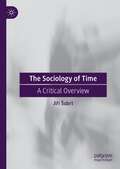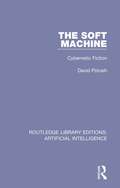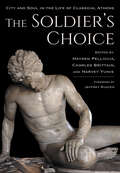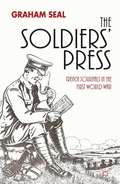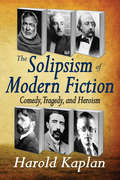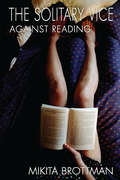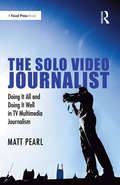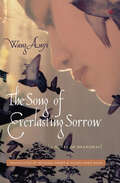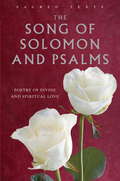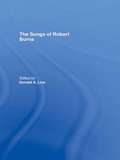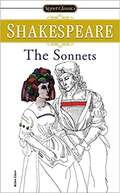- Table View
- List View
The Sociology of Time: A Critical Overview
by Jiří ŠubrtIn a critical, comparative study of the sociological literature, this book explores the term “time,” and the various interconnections between time and a broad cluster of topics that create a conceptual labyrinth. Various understandings of time manifest themselves in the context of many individual social problems—there is no single vision in sociology of how to grasp time and address within social theory. This book, therefore, attempts to define an approach to the concept of time and its associated terms (duration, temporality, acceleration, compression, temporal structures, change, historical consciousness, and others). The volume is guided by a critical engagement with three main questions: a) the formation of human understanding of time; b) the functioning of temporal structures at different levels of social reality; c) the role and place of time in general sociological theory.
The Sociology of Translation and the Politics of Sustainability: Explorations Across Cultures and Natures (ISSN)
by John Ødemark, Åmund Norum Resløkken, Ida Lillehagen, and Eivind EngebretsenThis book uses sustainability to explore the interfaces between translation studies, the cultural history of knowledge, and Science and Technology studies (STS).The volume examines various material, cultural and epistemic translation practices where sustainability serves as a boundary object between natural and cultural inquiry. By turning to the intellectual traditions that influenced but were left behind by STS and actor-network theory (ANT), we aim to challenge and expand the Sociology of Translation developed in ANT. Concepts such as ‘inscription’ (Derrida), ‘actant’, ‘narrative’ (Greimas), and ‘world/worlding’ (Heidegger, Spivak) were reemployed – translated – in the canonical STS-texts. What networks of meaning were left behind in this reemployment? The book showcases a combination of cultural and knowledge historical perspectives on the construction of the Sociology of Translation and practical experiments across the registers of nature and culture is novel. There have been brilliant individual attempts to realign the Sociology of Translation with narratives and modes of enunciation, but none has related the Sociology of Translation to the networks and traditions which enabled it but to which it erased its relations and debts.This innovative work will appeal to scholars in translation studies, cultural studies, environmental humanities, medical humanities, and Science and Technology studies.The Open Access version of this book, available at http://www.taylorfrancis.com, has been made available under a Creative Commons [Attribution-Non Commercial-No Derivatives (CC-BY-NC-ND)] 4.0 license.
The Sociomateriality of Leadership: A Ventriloquial Perspective (Routledge Studies in Communication, Organization, and Organizing)
by Jonathan CliftonWith the parallel expansion of both leadership research and the use of ventriloquism within communication studies, this book addresses the lack of connection between the two, arguing that ventriloquial analyses can add significant insights to leadership research and that leadership research can be a fruitful avenue of inquiry.Focusing on the ventriloquial approach to organising originating from the Montreal School, which emphasizes the analyses of “actions through which someone or something makes someone or something else say or do things”, the book offers a new and exciting way of looking at the materiality of leadership. Drawing on ventriloquial analyses of naturally-occurring workplace interaction; interviews with key organisational players; and training sessions about leadership, the author posits that other-than-human actants affect many areas of leadership and organisational communication.Offering fresh insight into leadership practice, this book will be an essential read for scholars and students of organisational communication, leadership, and management.
The Soft Machine: Cybernetic Fiction (Routledge Library Editions: Artificial Intelligence #8)
by David PorushThe Soft Machine, originally published in 1985, represents a significant contribution to the study of contemporary literature in the larger cultural and scientific context. David Porush shows how the concepts of cybernetics and artificial intelligence that have sparked our present revolution in computer and information technology have also become the source for images and techniques in our most highly sophisticated literature, postmodern fiction by Barthelme, Barth, Pynchon, Beckett, Burroughs, Vonnegut and others. With considerable skill, Porush traces the growth of "the metaphor of the machine" as it evolves both technologically and in literature of the twentieth century. He describes the birth of cybernetics, gives one of the clearest accounts for a lay audience of its major concepts and shows the growth of philosophical resistance to the mechanical model for human intelligence and communication which cybernetics promotes, a model that had grown increasingly influential in the previous decade. The Soft Machine shows postmodern fiction synthesizing the inviting metaphors and concepts of cybernetics with the ideals of art, a synthesis that results in what Porush calls "cybernetic fiction" alive to the myths and images of a cybernetic age.
The Soho Leopard
by Ruth PadelBeautiful, disturbing and a pleasure to read, Ruth Padel's new poems are her most ambitious yet, adding animal legend and zoological science to her glitteringly imaginative canvas. With her gift for bringing together experiences and tones of voice that normally stay far apart, she sweeps us from Dulwich Pizza Hut to ancient Siberia, King's Cross to nineteenth-century Burma. We meet Socrates, urban foxes, Louisiana alligators and the endangered Amur leopard in poems resonating with sensuous delight in nature, but also with history and loss.Finally, a Chinese painter searches for tigers in a forest doomed to the sawmill while the minister who sold it scoffs an aphrodisiac bowl of tiger-penis soup.Hallucinatory and lyrical, passionately musical, seething with life, The Soho Leopard explores our human need for wildness- and also for stories, wherever we find them. A wonderfully ferocious new collection from one of our most exciting poets.
The Soldier's Choice: City and Soul in the Life of Classical Athens (Cornell Studies in Classical Philology)
by Hayden Pelliccia Charles Brittain Harvey Yunis Jeffrey RustenIn the pitch of battle, according to Pericles, the Athenian citizen-soldier chooses to die rather than leave undefended the democratic principles that Athens embodies: this defines The Soldier's Choice. The great war between Sparta and Athens dominated the Greek world for twenty-seven years (431–404 BCE) and shaped much of the culture it bequeathed to posterity.The Sparta of that era did not produce writers, but Athens did: Thucydides, an unsuccessful general in the war, became its first historian; Aristophanes, Greece's greatest comic poet, devoted the first quarter century of his career to plays about the war; the foundational figure of Western philosophy, Plato, grew up in its shadow and populated his works with men of the war generation. Because their writings belong to different genres, these three seminal figures have rarely been treated together, an oversight The Soldier's Choice decisively corrects. As prominent members of a small intellectual community, each of the three wrote in profound engagement with the currents represented by the others. The contributors to this volume, experts in the relevant genres, reveal and explore these long-neglected interactions.Contributors: Sara Forsdyke, Edith Foster, Terence Irwin, Richard Kraut, Mary Margaret McCabe, Heinz-Günther Nesselrath, Hunter R. Rawlings III, Ralph M. Rosen, Jeffrey Rusten, Victoria Wohl, Nancy Worman, Harvey Yunis
The Soldier's Orphan: by Mrs Costello
by Clare Broome SaundersThis is a novel virtually forgotten by modern readers, but one that deserves reassessment with this critical edition. Raised by guardians, Louisa’s fate is intertwined with the neighbouring Stanley family, including the jealous younger daughter, Armida – whose husband Lord Belmour openly admires Louisa and which propels the plot forward.
The Soldier's Two Bodies: Military Sacrifice and Popular Sovereignty in Revolutionary War Veteran Narratives
by James GreeneIn The Soldier’s Two Bodies, James M. Greene investigates an overlooked genre of early American literature—the Revolutionary War veteran narrative—showing that it by turns both promotes and critiques a notion of military heroism as the source of U.S. sovereignty. Personal narratives by veterans of the American Revolution indicate that soldiers in the United States have been represented in two contrasting ways from the nation’s first days: as heroic symbols of the body politic and as human beings whose sufferings are neglected by their country. Published from 1779 through the late 1850s, narrative accounts of Revolutionary War veterans’ past service called for recognition from contemporary audiences, inviting readers to understand the war as a moment of violence central to the founding of the nation. Yet, as Greene reveals, these calls for recognition at the same time underscored how many veterans felt overlooked and excluded from the sovereign power they fought to establish. Although such narratives stem from a discourse that supports centralized, continental nationalism, they disrupt stable notions of a unified American people by highlighting those left behind. Greene discusses several well-known examples of the genre, including narratives from Ethan Allen, Joseph Plumb Martin, and Deborah Sampson, along with Herman Melville's fictional adaptation of the life of Israel Potter. Additional chapters focus on accounts of postwar frontier actions, including narratives collected by Hugh Henry Brackenridge that voice concerns over populist violence, along with stranger narratives like those of Isaac Hubbell and James Roberts, which register as fantastic imitations of the genre commenting on antebellum racial politics. With attention to questions of historical context and political ideology, Greene charts the process by which veteran narratives promote exception, violence, and autonomy, while also encouraging restraint, sacrifice, and collectivity. Revolutionary War veteran narratives offer no easy solutions to the appropriation of veterans’ lives within military nationalism and sovereign violence. But by bringing forward the paradox inherent in the figure of the U.S. soldier, the genre invites considerations of how to reimagine those representations. Drawing attention to paradoxes presented by the memory of the American Revolution, The Soldier’s Two Bodies locates the origins of a complicated history surrounding the representation of veterans in U.S. politics and culture.
The Soldiers' Press
by Graham SealThrough the first comprehensive investigation and analysis of the English language trench periodicals of the First World War, The Soldiers' Press presents a cultural interpretation of the means and methods through which consent was negotiated between the trenches and the home front.
The Solipsism of Modern Fiction: Comedy, Tragedy, and Heroism
by Harold KaplanIn 'The Solipsism of Modern Fiction', Harold Kaplan deals with the problem of action and its adequate motive in the modern novel. In the nineteenth and twentieth centuries modern scientific knowledge abandoned the human-centred view of the universe and thus the fictional modes that had been rooted in religion or myth. The result for fiction was a radical skepticism on the part of the protagonist who now appeared as a reflective, self-critical, passive figure lacking the dynamism of the epic hero or religious seeker. One response to the scientific worldview was the naturalism of Zola and his followers in which the action of characters is determined by social or biological forces. Kaplan, however, focuses his study on such novelists as Flaubert, Joyce, Conrad, Faulkner, Lawrence, and Hemingway who dramatised the isolated individual consciousness in contention with the world and with the ambiguity of their own motivations. 'The Solipsism of Modern Fiction' deals with several related topics that grow from one source, the crisis of knowledge in modern intellectual history. The effects of solipsism and of moral passivity, the split consciousness that divides action and understanding, the perspectives of primitive naturalism and stoic naturalism, the variations of the comic mood, and the example of tragedy, are all themes that are dramatised in Kaplan's readings of 'Madame Bovary', 'Light in August', 'Ulysses', 'Lord Jim', and other exemplary modern novels that associate themselves with the problem of self-criticism, knowing, and acting. Written by one of the outstanding literary scholars of our time, this book will inspire new generations of readers and writers.
The Solitary Vice: Against Reading
by Mikita BrottmanMikita Brottman wonders, just why is reading so great? It's a solitary practice, one that takes away from time that could be spent developing important social networking skills. Reading's not required for health, happiness, or a loving family. And, if reading is so important, why are catchy slogans like "Reading Changes Lives" and "Champions Read" needed to hammer the point home? Fearlessly tackling the notion that nonreaders are doomed to lives of despair and mental decay, Brottman makes the case that the value of reading lies not in its ability to ward off Alzheimer's or that it's a pleasant hobby. Rather, she argues that like that other well–known, solitary vice, masturbation, reading is ultimately not an act of pleasure but a tool for self–exploration, one that allows people to see the world through the eyes of others and lets them travel deep into the darkness of the human condition.
The Solo Video Journalist: Doing It All and Doing It Well in TV Multimedia Journalism
by Matt PearlIt is becoming increasingly important for television reporters to be proficient in many, if not all, of the steps in production. The Solo Video Journalist will make handling all these responsibilities seem possible, and do so from the hands-on perspective of a current reporter with years of experience as a multimedia journalist. This book will cover all aspects of multimedia journalism, from planning for a segment, to dressing appropriately for one’s multiple roles, to conducting interviews and editing. The instruction and guidance in this text will help make readers valuable players in their field, and it is filled with real-world examples and advice from current professionals. Whether it be college students learning from the ground up or journalists early in their careers, The Solo Video Journalist ensures they will have all the materials they need to be successful multimedia journalists.
The Solo Video Journalist: Doing It All and Doing It Well in TV Multimedia Journalism
by Matt PearlThe Solo Video Journalist, now in its second edition, offers a comprehensive overview of the solo video reporting process from start to finish. Drawing from years of professional experience in the field, the author covers all aspects of multimedia journalism, from planning for a segment, to dressing appropriately for multiple roles, to conducting interviews, and editing. The book contains interviews with more than a dozen top storytellers from around the United States and offers practical advice for how to succeed in a growing media field. New to this edition are Career Chronicles – chapters that detail the career paths possible for modern journalists – and a fully updated chapter on the importance of building a digital and social media presence. This book is an excellent resource for students learning skills in broadcast, multimedia, backpack, and television journalism, as well as for early-career professionals looking for a back-pocket resource in solo video journalism.
The Somali Within: Language, Race and Belonging in Minor Italian Literature
by Brioni SimoneThe recent histories of Italy and Somalia are closely linked. Italy colonized Somalia from the end of the 19th century to 1941, and held the territory by UN mandate from 1950 to 1960. Italy is also among the destination countries of the Somali diaspora, which increased in 1991 after civil war. Nonetheless, this colonial and postcolonial cultural encounter has often been neglected. Critically evaluating Gilles Deleuze and F�x Guattari�s concept of �minor literature�, as well as drawing on postcolonial literary studies, The Somali Within analyses the processes of linguistic and cultural translation and self-translation, the political engagement with race, gender, class and religious discrimination, and the complex strategies of belonging and unbelonging at work in the literary works in Italian by authors of Somali origins. Brioni proposes that the �minor� Somali Italian connection might offer a major insight into the transnational dimension of contemporary �Italian� literature and �Somali� culture.
The Song of Everlasting Sorrow: A Novel of Shanghai (Weatherhead Books on Asia)
by Anyi WangSet in post-World War II Shanghai, The Song of Everlasting Sorrow follows the adventures of Wang Qiyao, a girl born of the longtong, the crowded, labyrinthine alleys of Shanghai's working-class neighborhoods. Infatuated with the glitz and glamour of 1940s Hollywood, Wang Qiyao seeks fame in the Miss Shanghai beauty pageant, and this fleeting moment of stardom becomes the pinnacle of her life. During the next four decades, Wang Qiyao indulges in the decadent pleasures of pre-liberation Shanghai, secretly playing mahjong during the antirightist Movement and exchanging lovers on the eve of the Cultural Revolution. Surviving the vicissitudes of modern Chinese history, Wang Qiyao emerges in the 1980s as a purveyor of "old Shanghai"—a living incarnation of a new, commodified nostalgia that prizes splendor and sophistication—only to become embroiled in a tragedy that echoes the pulpy Hollywood noirs of her youth. From the violent persecution of communism to the liberalism and openness of the age of reform, this sorrowful tale of old China versus new, of perseverance in the face of adversity, is a timeless rendering of our never-ending quest for transformation and beauty.
The Song of Roland
by Glyn S. BurgessOn 15 August 778 Charlemagne's army was returning from a successful expedition against Saracen Spain when its rearguard was ambushed in a remote Pyrenean pass. Out of this skirmish arose a stirring tale or war, which was recorded in the oldest extant epic poem in French. The Song of Roland, written by an unknown poet, tells of Charlemagne's warrior nephew, Lord of the Breton Marches, who valiantly leads his men into battle against the Saracens, but dies in the massacre, defiant to the end. In majestic verses, the battle becomes a symbolic struggle between Christianity and paganism, while Roland's last stand is the ultimate expression of honour and feudal values of twelfth-century France. Glyn Burgess's lucid translation is designed to assist the reader in understanding the original French of the Chanson de Roland, of which a substantial portion is included as an appendix in this volume. This edition also includes notes and an updated list for further reading.
The Song of Solomon and Psalms
by Gerald BenedictThis is a wonderful collection of some of the best-known and best-loved poetic texts from the Old Testament, as translated in the King James Bible.
The Song of Songs: A Biography (Lives of Great Religious Books #46)
by Ilana PardesAn essential history of the greatest love poem ever writtenThe Song of Songs has been embraced for centuries as the ultimate song of love. But the kind of love readers have found in this ancient poem is strikingly varied. Ilana Pardes invites us to explore the dramatic shift from readings of the Song as a poem on divine love to celebrations of its exuberant account of human love. With a refreshingly nuanced approach, she reveals how allegorical and literal interpretations are inextricably intertwined in the Song's tumultuous life. The body in all its aspects—pleasure and pain, even erotic fervor—is key to many allegorical commentaries. And although the literal, sensual Song thrives in modernity, allegory has not disappeared. New modes of allegory have emerged in modern settings, from the literary and the scholarly to the communal.Offering rare insights into the story of this remarkable poem, Pardes traces a diverse line of passionate readers. She looks at Jewish and Christian interpreters of late antiquity who were engaged in disputes over the Song's allegorical meaning, at medieval Hebrew poets who introduced it into the opulent world of courtly banquets, and at kabbalists who used it as a springboard to the celestial spheres. She shows how feminist critics have marveled at the Song's egalitarian representation of courtship, and how it became a song of America for Walt Whitman, Herman Melville, and Toni Morrison. Throughout these explorations of the Song's reception, Pardes highlights the unparalleled beauty of its audacious language of love.
The Songs We Know Best: John Ashbery's Early Life
by Karin RoffmanThe first biography of an American masterThe Songs We Know Best, the first comprehensive biography of the early life of John Ashbery—the winner of nearly every major American literary award—reveals the unusual ways he drew on the details of his youth to populate the poems that made him one of the most original and unpredictable forces of the last century in arts and letters.Drawing on unpublished correspondence, juvenilia, and childhood diaries as well as more than one hundred hours of conversation with the poet, Karin Roffman offers an insightful portrayal of Ashbery during the twenty-eight years that led up to his stunning debut, Some Trees, chosen by W. H. Auden for the 1955 Yale Younger Poets Prize. Roffman shows how Ashbery’s poetry arose from his early lessons both on the family farm and in 1950s New York City—a bohemian existence that teemed with artistic fervor and radical innovations inspired by Dada and surrealism as well as lifelong friendships with painters and writers such as Frank O’Hara, Jane Freilicher, Nell Blaine, Kenneth Koch, James Schuyler, and Willem de Kooning. Ashbery has a reputation for being enigmatic and playfully elusive, but Roffman’s biography reveals his deft mining of his early life for the flint and tinder from which his provocative later poems grew, producing a body of work that he calls “the experience of experience,” an intertwining of life and art in extraordinarily intimate ways.
The Songs of Robert Burns
by Donald A. LowIn this definitive work for our generation, Donald Low brings together, for the first time, the words and tunes of all Burns' known songs, both `polite' and bawdy. The Songs of Robert Burns were, in their author's eyes, the crown of his achievement as a poet. After years of study and investigation, many hours spent listening to old airs, as he recalled the living, daily, song-life of the people of Scotland, and through the creation of some of the finest lyric poetry produced in the British Isles, Burns' success is beyond doubt.
The Sonic Color Line: Race and the Cultural Politics of Listening (Postmillennial Pop #17)
by Jennifer Lynn StoeverThe unheard history of how race and racism are constructed from sound and maintained through the listening ear. Race is a visual phenomenon, the ability to see “difference.” At least that is what conventional wisdom has lead us to believe. Yet, The Sonic Color Line argues that American ideologies of white supremacy are just as dependent on what we hear—voices, musical taste, volume—as they are on skin color or hair texture. Reinforcing compelling new ideas about the relationship between race and sound with meticulous historical research, Jennifer Lynn Stoever helps us to better understand how sound and listening not only register the racial politics of our world, but actively produce them. Through analysis of the historical traces of sounds of African American performers, Stoever reveals a host of racialized aural representations operating at the level of the unseen—the sonic color line—and exposes the racialized listening practices she figures as “the listening ear.” Using an innovative multimedia archive spanning 100 years of American history (1845-1945) and several artistic genres—the slave narrative, opera, the novel, so-called “dialect stories,” folk and blues, early sound cinema, and radio drama—The Sonic Color Line explores how black thinkers conceived the cultural politics of listening at work during slavery, Reconstruction, and Jim Crow. By amplifying Harriet Jacobs, Frederick Douglass, Elizabeth Taylor Greenfield, Charles Chesnutt, The Fisk Jubilee Singers, Ann Petry, W.E.B. Du Bois, and Lena Horne as agents and theorists of sound, Stoever provides a new perspective on key canonical works in African American literary history. In the process, she radically revises the established historiography of sound studies. The Sonic Color Line sounds out how Americans have created, heard, and resisted “race,” so that we may hear our contemporary world differently.
The Sonnet (The Critical Idiom Reissued #25)
by John FullerFirst published in 1972, this book examines the sonnet, one of the most complex yet accessible of verse forms. It traces its history, concentrating primarily on its technical development, and fully explains the differences between the Italian and English sonnet. The study looks at several different kinds of sonnet, including condensed and expanded sonnets, inverted and tailed sonnets and irregularities of metre and rhyme, and concludes with a survey of the sonnet sequence. This book will be useful to students of prosody and English poetry as well as those concerned with the practice of verse.
The Sonnets
by William Shakespeare Sylvan BarnetThe Signet Classic Shakespeare Series The work of the world’s greatest dramatist edited by outstanding scholars The Sonnets UNIQUE FEATURES OF THE SIGNET CLASSICS SHAKESPEARE • An extensive overview of Shakespeare’s life, world, and sonnets by the general editor of the Signet Classics Shakespeare series, Sylvan Barnet, Tufts University • Special introduction to The Sonnets, by W. H. Auden • Literary criticism by William Empson, Hallett Smith, Winifred M. T. Nowottny, and Helen Vendler • Detailed footnotes at the bottom of each page of the sonnets • List of recommended reading • All text printed in the clearest, most readable type
The Sorrows of Fat City: A Selection of Literary Essays and Reviews
by George P. Garrett"The Sorrows of Fat City" is a representative sampling of critical literary essays written by George Garrett and published between 1957 and 1990. One of America's most accomplished and highly acclaimed writers, poet and novelist Garrett has been writing book reviews and critical essays since the outset of his career. In this volume, he treats several subjects including the Elizabethans, writers who have influenced him, the work of William Faulkner, Southern literature, and contemporary writers.
The Soul Of Place
by Linda LappinIn this engaging creative writing workbook, novelist and poet Linda Lappin presents a series of insightful exercises to help writers of all genres--literary travel writing, memoir, poetry, fiction, creative nonfiction--discover imagery and inspiration in the places they love. Lappin departs from the classical concept of the Genius Loci, the indwelling spirit residing in every landscape, house, city, or forest--to argue that by entering into contact with the unique energy and identity of a place, writers can access an inexhaustible source of creative power. The Soul of Place provides instruction on how to evoke that power. The writing exercises are drawn from many fields--architecture, painting, cuisine, literature and literary criticism, geography and deep maps, Jungian psychology, fairy tales, mythology, theater and performance art, metaphysics--all of which offer surprising perspectives on our writing and may help us uncover raw materials for fiction, essays, and poetry hidden in our environment. An essential resource book for the writer’s library, this book is ideal for creative writing courses, with stimulating exercises adaptable to all genres. For writers or travelers about to set out on a trip abroad, The Soul of Place is the perfect road trip companion, attuning our senses to a deeper awareness of place.
